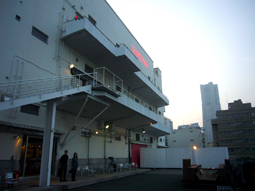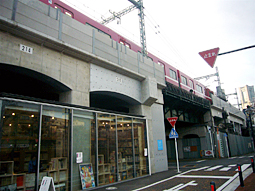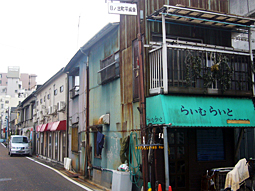 |
|
 |
| Twilight on the bayside deck of BankART Studio NYK, a former shipping warehouse. In the background looms Landmark Tower, Japan's tallest building. |
|
The interior of the Kogane Studio, built in 2008 and housing several exhibition spaces and a café under the Keikyu Railway tracks. |
Once regarded as a quaint appurtenance to its megalopolitan neighbor Tokyo, Yokohama has come into its own in the 21st century, not least as a mecca for the arts. A new city by Japanese standards, Yokohama 150 years ago was an obscure fishing village on the southwestern shore of Tokyo Bay. Fate, in the form of Commodore Perry, who pressured the Shogunate to open a port near Tokyo (then Edo) to trade with the West, decreed that the hamlet would grow practically overnight into Japan's premier gateway to foreign goods and people. Along the way it has acquired an international flavor rare among Japanese cities, complete with its own Chinatown.
Recently, Yokohama surpassed Osaka in population to become the nation's second largest city. Yet its harbor district still retains a cozy, old-time ambience missing from Japan's other urban centers. Yokohama's municipal government has helped in this regard by pursuing enlightened cultural policies that have preserved many of the city's older buildings and warehouses and turned them into spaces that now hold art galleries, studios, and other culturally worthy enterprises.
|
 |
|
Yuri Sakamoto's storefront installation "Crows and Houses" at Hatsune Studio in the Koganecho district, Yokohama. |
For the art aficionado, there is far too much to see here in one day, but if a day trip is all you can afford to Yokohama, it's well worth it. Fortunately the compact nature of the city lends itself to pleasant strolls between neighborhoods. Two must-see art spots that are within walking distance of each other are BankART Studio NYK and the Koganecho art district. Both are beneficiaries of municipal generosity in recent years, but such munificence can be fleeting. In the wake of the recent global economic meltdown, funding has dried up and some highly meritorious art projects have had to shut down -- notably the ZAIM Project, which filled a fine old brick building with artist studios and galleries, but was forced to close its doors in March after five years of operation.
BankART 1929, so named because it initially occupied the elegant Dai-Ichi Bank building (built in 1929), is a project launched in 2004 by the Yokohama government to use historical city-owned buildings for arts-related purposes. The city provides the space rent-free. BankART is currently housed in a much larger building, a converted dockside warehouse formerly owned by the Nippon Yusen Kaisha (NYK) shipping company. (Meanwhile, the bank building has been taken over by another city-sponsored project, Creativecity Yokohama, which holds artistic and cultural functions there.)
In addition to a well-stocked art bookstore and a café with a stunning harbor view, Studio NYK has three floors' worth of cavernous exhibition spaces, as well as numerous small studios which it loans out for short-term artist residencies. The galleries, stripped to their stark concrete substrate and interrupted only by rows of massive supporting pillars, are perfect for large-scale installations, performances, and anything else, really, that contemporary artists are likely to come up with.
During the first three months of the year (the end of Japan's school term), BankART gives the galleries over to exhibitions by graduating students from Japan's art universities. In March this year, students from the Kurashiki University of Science and the Arts in Okayama Prefecture displayed some impressively mature work, much of it employing the natural pigments of Nihonga and demonstrating a seriousness of theme and a devotion to craft that often seem lacking in the more conceptual, cartoony oeuvre of many young Tokyo artists. A standout was Isao Nagahara's series of subdued, nearly abstract Nihonga paintings of parched desert soil and vegetation.
Leaving the harbor and heading up the Ooka River, one soon arrives in the riverbank neighborhoods of Hinodecho, Hatsunecho and Koganecho. Once a notorious red-light district, the area has in the last couple of years undergone a rather astonishing transformation into an enclave of contemporary artists. Pivotal to its past and present identity is the presence of the Keikyu Railway's overhead tracks, which provided shelter for the bars and brothels that sprang up here after the war and now pass above new art spaces and trendy bistros.
|
 |
|
Yuri Sakamoto's ceramic "Coffee + Morning" sits on the counter alongside what is left of the real thing, polished off by a satisfied customer at L CAMP. |
Since 2008 the nonprofit Koganecho Area Management Center has received city funding to manage the neighborhood's mix of large and small studio and gallery spaces -- some occupying the old barracks-like storefronts along narrow alleys, some built from scratch on vacant lots under the tracks. Strolling between the adjacent Keikyu stations of Hinodecho and Koganecho, you are liable to come across any number of art-related venues no matter which street you choose. But I recommend the walk along the river, particularly during cherry blossom season, when the trees lining both banks are in full glory and it is hard to believe the neighborhood was ever a place of ill repute.
If the walk makes you hungry, you can have your artistic cake and eat it too at L CAMP, a whimsical studio-cum-café in the Hatsune Studio complex. According to L PACK, an art duo consisting of Susumu Odagiri and Tetsuya Nakajima, the café itself -- or rather, the process of brewing and serving coffee and light fare to their customers -- is the art. Certainly the layout is perfect for this purpose; from upstairs, you can look directly down on the large kitchen range where Odagiri and Nakajima prepare your meal. I recommend the "Coffee + Morning" set -- a breakfast plate served all day -- which you can enjoy while ogling Yuri Sakamoto's eerily lifelike ceramic sculpture of the same dish, clay eggs (sunnyside up) and all.
The happy combination of art and food seems to be a recurring theme in Yokohama. One of the more enduring new traditions to catch on here is the "full course" tour organized by BankART every spring (see this month's Picks section for a short review). For two weeks in late March, participants could follow a three-hour course (either lunch or dinner time, by reservation only) starting from Studio NYK's café and wending its way up the Ooka River to Koganecho, with stops at hip food-as-art places like L CAMP, established eateries in the adjacent bar district of Noge, and even the house of a family offering bona fide home-cooked meals.
A walk through Koganecho, or between there and the harbor, will barely scratch the surface of Yokohama's thriving contemporary arts scene. But such meanderings are guaranteed to lead to other, equally stimulating artistic and cultural encounters in this gem of a city by the bay.
 |
|
 |
| Train passing over the shop at Hinode Studio, one of two multipurpose spaces built under the Keikyu tracks and operated by the Koganecho Area Management Center. |
|
The Limelight bar, a corrugated-tin remnant of Koganecho's heyday as a red-light district.
All photos by Alan Gleason
|
|
|